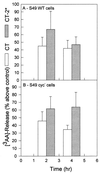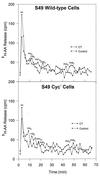Cholera toxin B subunit activates arachidonic acid metabolism
- PMID: 9916092
- PMCID: PMC96388
- DOI: 10.1128/IAI.67.2.794-799.1999
Cholera toxin B subunit activates arachidonic acid metabolism
Abstract
Cholera toxin (CT) increases intestinal secretion of water and electrolytes and modulates the mucosal immune response by stimulating cellular synthesis of arachidonic acid (AA) metabolites (e.g., prostaglandin E2), as well as the intracellular second messenger cyclic AMP (cAMP). While much is known about the mechanism of CT stimulation of adenylate cyclase, the toxin's activation of phospholipase A2, which results in increased hydrolysis of AA from membrane phospholipids, is not well understood. To determine whether CT activation of AA metabolism requires CT's known enzymatic activity (i.e., ADP-ribosylation of GSalpha), we used native CT and a mutant CT protein (CT-2*) lacking ADP-ribose transferase activity in combination with S49 wild-type (WT) and S49 cyc- murine Theta (Th)1.2-positive lymphoma cells deficient in GSalpha. The experimental results showed that native CT stimulated the release of [3H[AA from S49 cyc- cells at a level similar to that for S49 WT cells, indicating that GSalpha is not essential for this process. Further, levels of cAMP in the CT-treated cyc- cells remained the same as those in the untreated control cells. The ADP-ribosyltransferase-deficient CT-2* protein, which was incapable of increasing synthesis of cAMP, displayed about the same capacity as CT to evoke the release of [3H]AA metabolites from both S49 WT and cyc- cells. We concluded that stimulation of arachidonate metabolism in S49 murine lymphoma cells by native CT does not require enzymatically functional CT, capable of catalyzing the ADP-ribosylation reaction. These results demonstrated for the first time that stimulation of adenylate cyclase by CT and stimulation of AA metabolism by CT are not necessarily coregulated. In addition, the B subunits purified from native CT and CT-2* both simulated the release of [3H]AA from S49 cyc- cells and murine monocyte/macrophage cells (RAW 264.7), suggesting a receptor-mediated cell activation process of potential importance in enhancing immune responses to vaccine components.
Figures


Similar articles
-
Gsalpha-mediated regulation of the carnitine carrier in S49 lymphoma cells.Biochim Biophys Acta. 1998 Jul 17;1372(2):255-60. doi: 10.1016/s0005-2736(98)00063-7. Biochim Biophys Acta. 1998. PMID: 9675303
-
Interaction of beta-adrenergic receptors with the inhibitory guanine nucleotide-binding protein of adenylate cyclase in membranes prepared from cyc- S49 lymphoma cells.Biochem Pharmacol. 1988 Nov 15;37(22):4289-97. doi: 10.1016/0006-2952(88)90609-0. Biochem Pharmacol. 1988. PMID: 2848525
-
Expression and characterization of the long and short splice variants of GS alpha in S49 cyc- cells.Mol Pharmacol. 1991 Jun;39(6):702-10. Mol Pharmacol. 1991. PMID: 1646945
-
Dopamine D2 receptor signaling via the arachidonic acid cascade: modulation by cAMP-dependent protein kinase A and prostaglandin E2.J Lipid Mediat. 1993 Mar-Apr;6(1-3):433-43. J Lipid Mediat. 1993. PMID: 8395253 Review.
-
Cholera: pathophysiology and emerging therapeutic targets.Future Med Chem. 2013 May;5(7):781-98. doi: 10.4155/fmc.13.42. Future Med Chem. 2013. PMID: 23651092 Review.
Cited by
-
Molecular Biology of Escherichia Coli Shiga Toxins' Effects on Mammalian Cells.Toxins (Basel). 2020 May 23;12(5):345. doi: 10.3390/toxins12050345. Toxins (Basel). 2020. PMID: 32456125 Free PMC article. Review.
-
Intranasal immunization with synthetic peptides corresponding to the E6 and E7 oncoproteins of human papillomavirus type 16 induces systemic and mucosal cellular immune responses and tumor protection.Vaccine. 2007 Apr 30;25(17):3302-10. doi: 10.1016/j.vaccine.2007.01.010. Epub 2007 Jan 24. Vaccine. 2007. PMID: 17291642 Free PMC article.
-
Post-infection irritable bowel syndrome in the tropical and subtropical regions: Vibrio cholerae is a new cause of this well-known condition.Indian J Gastroenterol. 2019 Apr;38(2):87-94. doi: 10.1007/s12664-019-00959-2. Indian J Gastroenterol. 2019. PMID: 31073702 Review. No abstract available.
-
Inhibition of attaching and effacing lesion formation following enteropathogenic Escherichia coli and Shiga toxin-producing E. coli infection.Infect Immun. 2001 Nov;69(11):7152-8. doi: 10.1128/IAI.69.11.7152-7158.2001. Infect Immun. 2001. PMID: 11598092 Free PMC article.
References
-
- Beubler E, Bukhave K, Rask-Madsen J. Significance of calcium for protstaglandin E2-mediated secretory response to 5-hydroxytryptamine in the small intestine of the rat in vivo. Gastroenterology. 1986;90:1972–1977. - PubMed
-
- Beubler E, Kollar G, Saria A, Bukhave K, Rask-Madsen J. Involvement of 5-hydroxytryptamine, prostaglandin E2, and cyclic adenosine monophosphate in cholera toxin-induced fluid secretion in the small intestine of the rat in vivo. Gastroenterology. 1989;96:368–376. - PubMed
-
- Bourne H R, Coffino P, Tomkins G M. Selection of a variant lymphoma cell deficient in adenylate cyclase. Science. 1975;187:750–752. - PubMed
Publication types
MeSH terms
Substances
Grants and funding
LinkOut - more resources
Full Text Sources
Other Literature Sources
Research Materials

